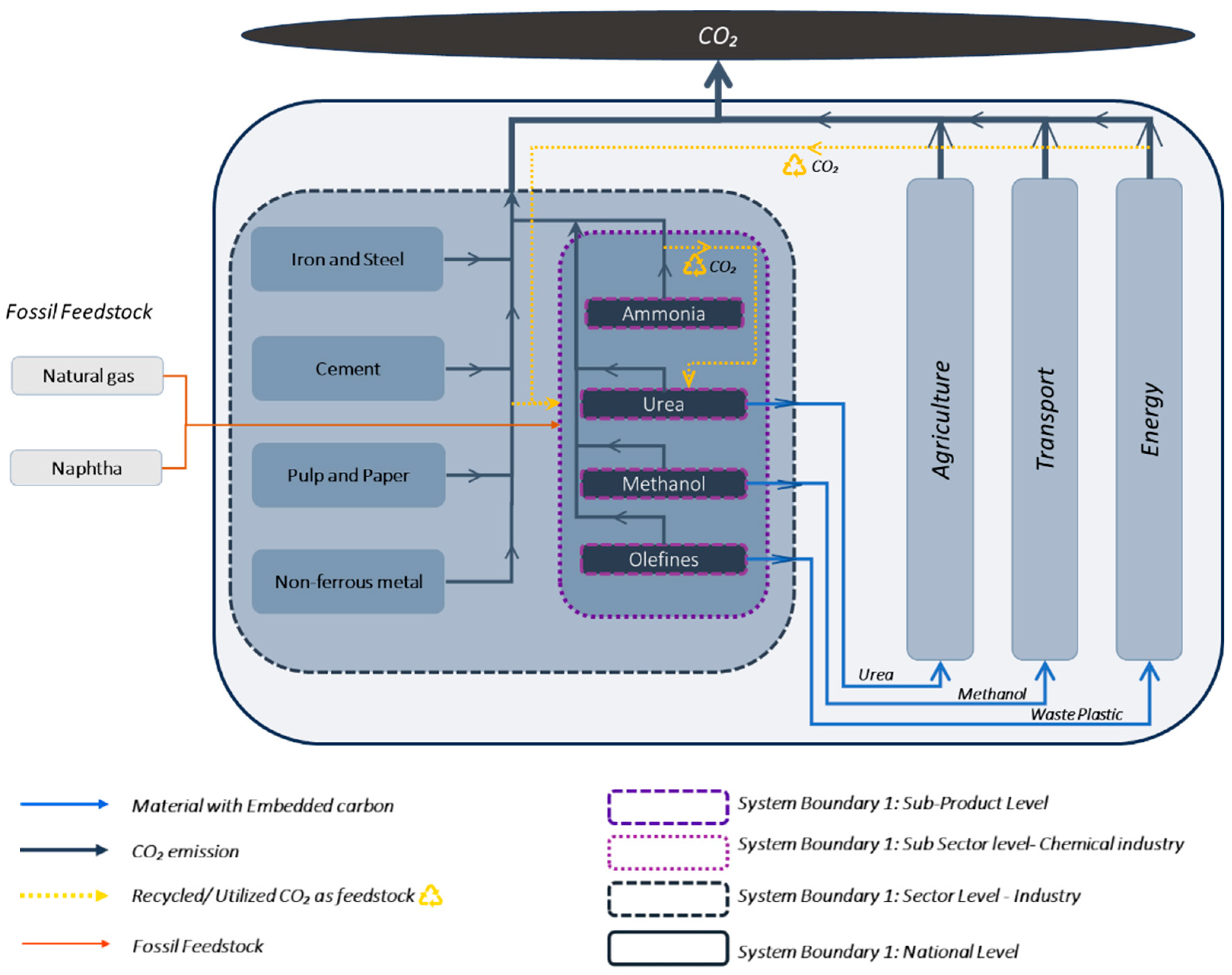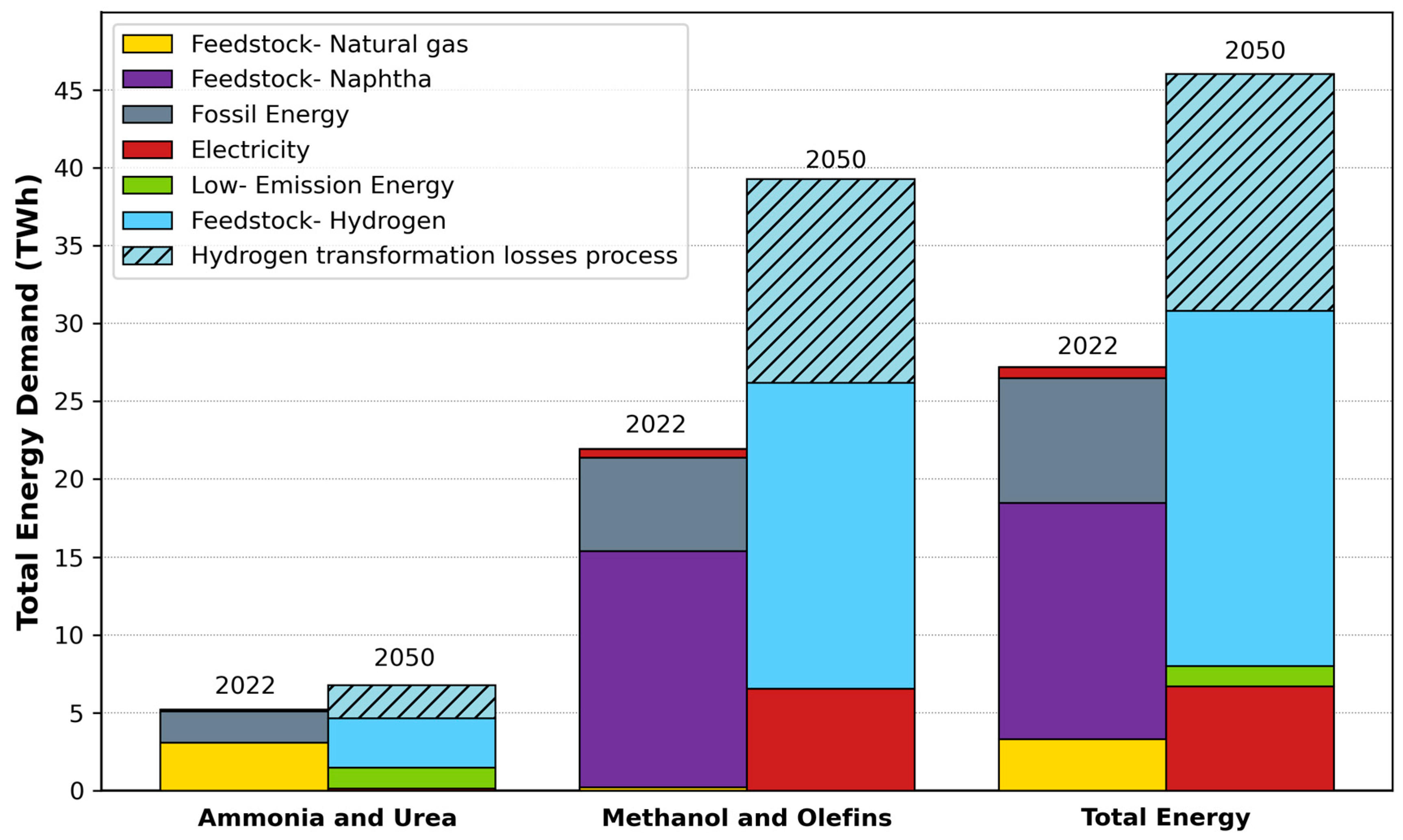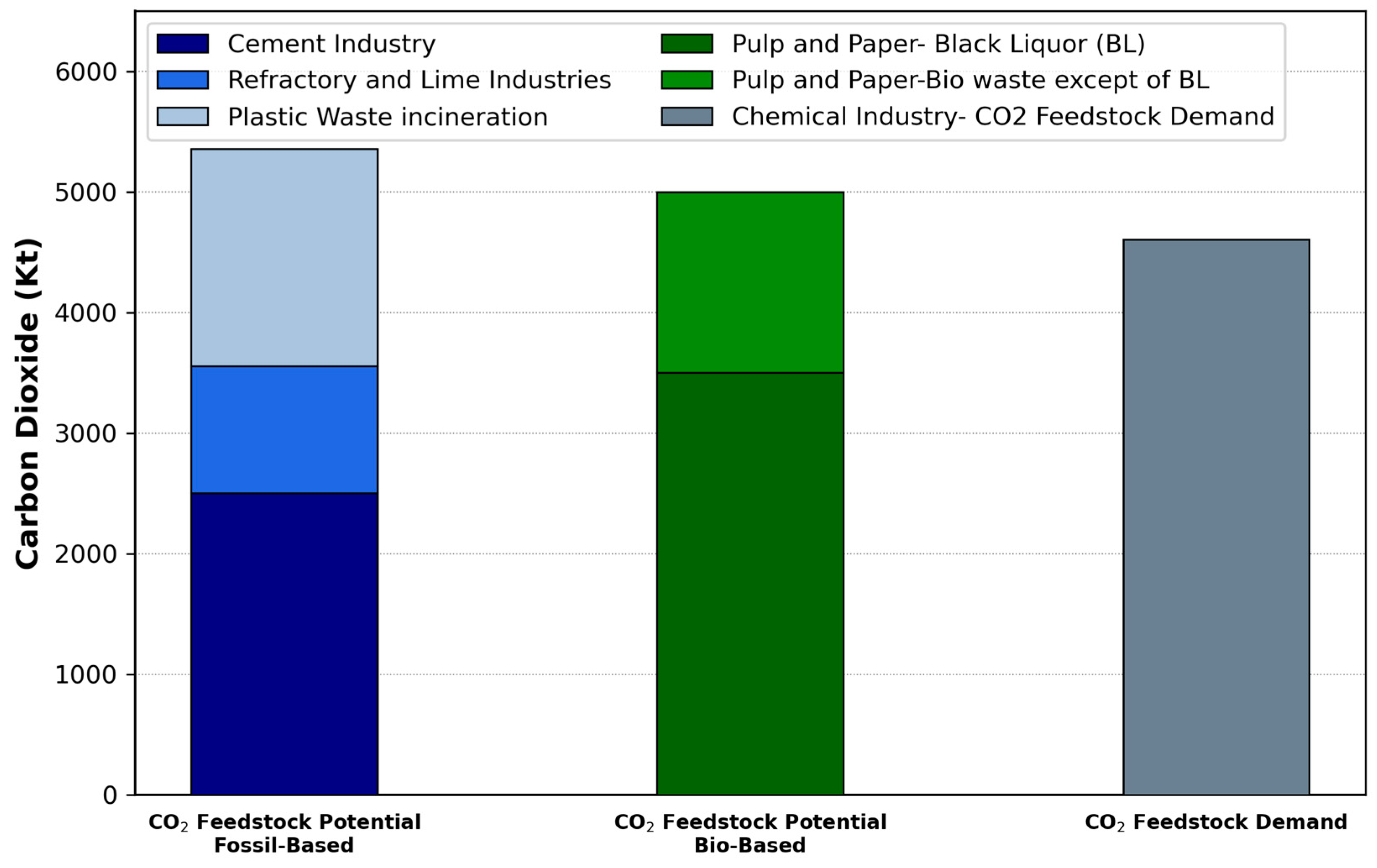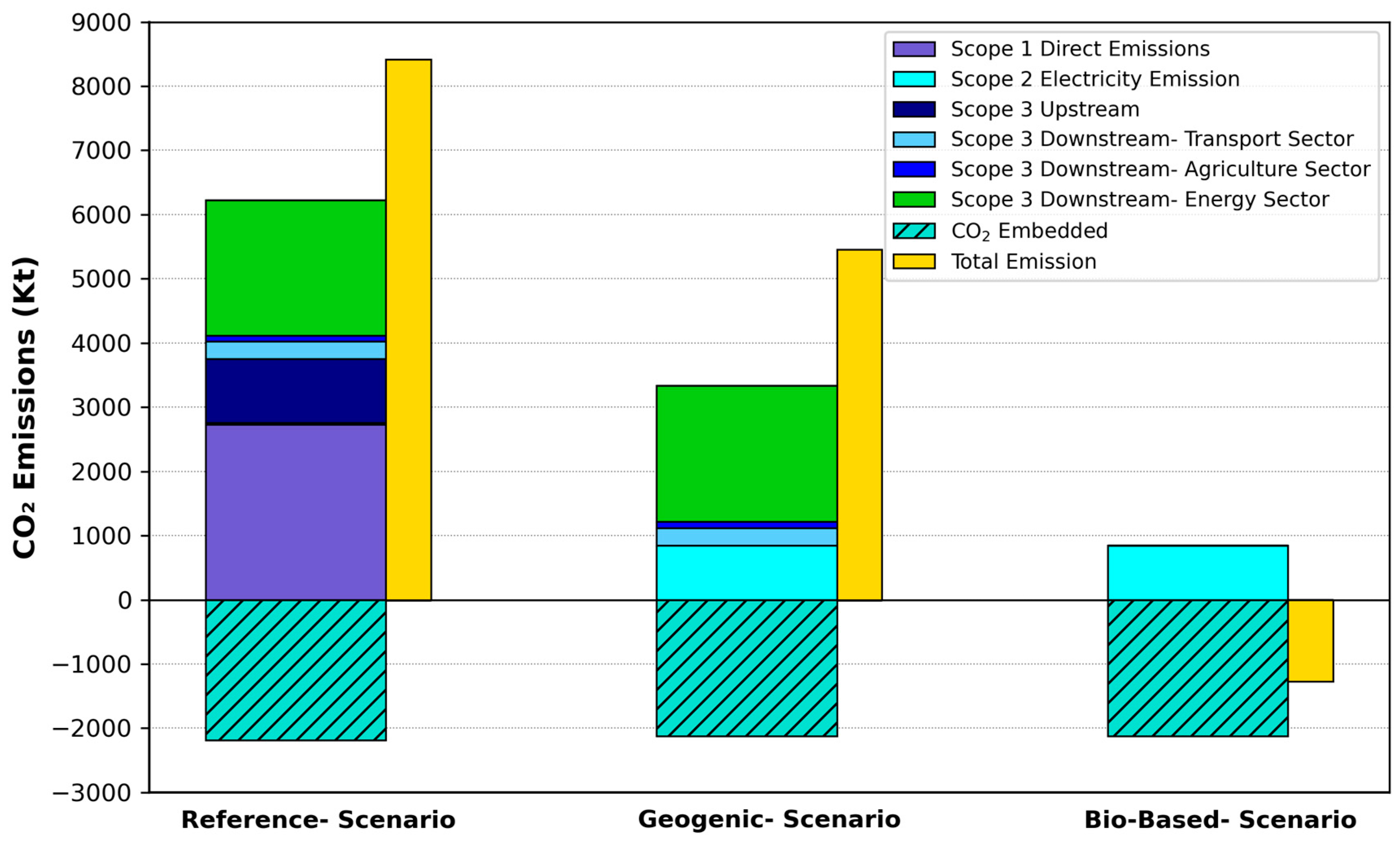Climate Neutrality Strategies for the Chemical Industry Using a Novel Carbon Boundary: An Austrian Case Study
Abstract
1. Introduction
Objective and Structure
- Identifying key technologies crucial for reducing emissions and transitioning primary chemicals to low-carbon products.
- Adjusting the carbon boundary for the chemical industry and evaluating emission reduction throughout the chemical commodity value chain—from production to consumption and end-of-life—with a special focus on downstream Scope 3 emissions.
- Clarifying the role of cross-sectoral approaches and lifecycle assessments in achieving climate neutrality by addressing emissions beyond the chemical industry’s system boundaries.
- Analyzing the impact of CO2 feedstock sources—fossil, geogenic, or biogenic—for chemical products on national-level emissions within an extended system boundary.
2. Methodology
3. Chemical Industry
3.1. Structure of the Chemical Industry
3.2. Ammonia and Urea
3.2.1. Current Production Process
3.2.2. Emission Reduction Technology
3.3. Methanol
3.3.1. Current Production Process
3.3.2. Emission Reduction Technology
3.4. Olefin
3.4.1. Current Production Process
3.4.2. Emission Reduction Technology
4. Austrian Chemical Industry
5. Emission Reduction Strategies and Emission Balance Using Novel Carbon Boundary for the Austrian Chemical Industry
6. Conclusions and Outlook
Author Contributions
Funding
Data Availability Statement
Conflicts of Interest
References
- IEA. Energy Technology Perspectives 2020; IEA: Paris, France, 2020; Available online: https://www.iea.org/reports/energy-technology-perspectives-2020 (accessed on 25 February 2022).
- IEA. Industry. Available online: https://www.iea.org/reports/industry (accessed on 13 January 2023).
- Schiffer, Z.J.; Manthiram, K. Electrification and Decarbonization of the Chemical Industry. Joule 2017, 1, 10–14. [Google Scholar] [CrossRef]
- Vooradi, R.; Anne, S.B.; Tula, A.K.; Eden, M.R.; Gani, R. Energy and CO2 management for chemical and related industries: Issues, opportunities and challenges. BMC Chem. Eng. 2019, 1, 7. [Google Scholar] [CrossRef]
- Saygin, D.; Gielen, D. Zero-Emission Pathway for the Global Chemical and Petrochemical Sector. Energies 2021, 14, 3772. [Google Scholar] [CrossRef]
- De Pee, A.; Pinner, D.; Roelofsen, O.; Somers, K.; Speelmen, E.; Witteveen, M. Decarbonization of Industrial Sectors: The Next Frontier; McKinsey&Company: Amsterdam, The Netherlands, 2018; Available online: https://www.mckinsey.com/~/media/McKinsey/Business%20Functions/Sustainability/Our%20Insights/How%20industry%20can%20move%20toward%20a%20low%20carbon%20future/Decarbonization-of-industrial-sectors-The-next-frontier.ashx (accessed on 2 August 2023).
- Griffin, P.W.; Hammond, G.P.; Norman, J.B. Industrial energy use and carbon emissions reduction in the chemicals sector: A UK perspective. Appl. Energy 2018, 227, 587–602. [Google Scholar] [CrossRef]
- Chung, C.; Kim, J.; Sovacool, B.K.; Griffiths, S.; Bazilian, M.; Yang, M. Decarbonizing the chemical industry: A systematic review of sociotechnical systems, technological innovations, and policy options. Energy Res. Soc. Sci. 2023, 96, 102955. [Google Scholar] [CrossRef]
- Boulamanti, A.; Moya, J.A. Energy Efficiency and GHG Emissions: Prospective Scenarios for the Chemical and Petrochemical Industry; European Commission: Luxembourg, 2017. [Google Scholar]
- Cefic. European Chemistry for Growth: Unlocking a Competitive, Low Carbon and Energy Efficient Future; Cefic: Brussels, Belgium, 2013. [Google Scholar]
- Bazzanella, A.M.; Ausfelder, F. Low Carbon Energy and Feedstock for the European Chemical Industry; DECHEMA Gesellschaft fur Chemische Technik und Biotechnologie e.V.: Frankfurt, Germany, 2017. [Google Scholar]
- DECHEMA/IEA/ICCA. Energy and GHG Reductions in the Chemical Industry via Catalytic Processes: ANNEXES. 2013. Available online: https://iea.blob.core.windows.net/assets/fc71e0ab-aef1-4d06-b9c2-caf293a91c6e/Technology_Roadmap_Catalytic_Processes_Annexes.pdf (accessed on 20 December 2023).
- Talaei, A.; Ahiduzzaman, M.; Kumar, A. Assessment of long-term energy efficiency improvement and greenhouse gas emissions mitigation potentials in the chemical sector. Energy 2018, 153, 231–247. [Google Scholar] [CrossRef]
- Lyons, M.; Durrant, P.; Kochhar, K. Reaching Zero with Renewables: Capturing Carbon; International Renewable Energy Agency: Abu Dhabi, United Arab Emirates, 2021. [Google Scholar]
- Gabrielli, P.; Gazzani, M.; Mazzotti, M. The Role of Carbon Capture and Utilization, Carbon Capture and Storage, and Biomass to Enable a Net-Zero-CO2 Emissions Chemical Industry. Ind. Eng. Chem. Res. 2020, 59, 7033–7045. [Google Scholar] [CrossRef]
- World Economic Forum. Primary Chemicals Industry Net-Zero Tracker; World Economic Forum: Cologny, Switzerland, 2024; Available online: https://reports.weforum.org/docs/WEF_Net_Zero_Industry_Tracker_2024_Primary_Chemicals.pdf?utm_source=chatgpt.com (accessed on 10 November 2024).
- Huang, K.; Peng, X.; Kong, L.; Wu, W.; Chen, Y.; Maravelias, C.T. Greenhouse Gas Emission Mitigation Potential of Chemicals Produced from Biomass. ACS Sustain. Chem. Eng. 2021, 9, 14480–14487. [Google Scholar] [CrossRef]
- Ausfelder, F.; Herrmann, E.O.; López González, L.F. Perspective Europe 2030: Technology Options for CO2- Emission Reduction of Hydrogen Feedstock in Ammonia Production; DECHEMA Gesellschaft für Chemische Technik und Biotechnologie e.V.: Frankfurt am Main, Germany, 2022; ISBN 978-3-89746-237-3. [Google Scholar]
- Saygin, D.; Blanco, H.; Boshell, F.; Cordonnier, J.; Rouwenhorst, K.; Lathwal, P.; Gielen, D. Ammonia Production from Clean Hydrogen and the Implications for Global Natural Gas Demand. Sustainability 2023, 15, 1623. [Google Scholar] [CrossRef]
- Winterton, N. The green solvent: A critical perspective. Clean Technol. Environ. Policy 2021, 23, 2499–2522. [Google Scholar] [CrossRef]
- Sustainable Manufacturing Expo. Environmental Impacts of Traditional Solvents. Available online: https://www.sustainablemanufacturingexpo.com/en/articles/environmental-impacts-solvents.html (accessed on 20 August 2024).
- Eryazici, I.; Ramesh, N.; Villa, C. Electrification of the chemical industry—Materials innovations for a lower carbon future. MRS Bull. 2021, 46, 1197–1204. [Google Scholar] [CrossRef]
- Hundertmark, T.; Mayer, M.; McNally, C.; Simons, T.J.; Witte, C. How Plastics-Waste Recycling Could Transform the Chemical Industry; McKinsey&Company: New York, NY, USA, 2018; Available online: https://www.mckinsey.com/~/media/mckinsey/industries/chemicals/our%20insights/how%20plastics%20waste%20recycling%20could%20transform%20the%20chemical%20industry/how-plastics-waste-recycling-could-transform.pdf?shouldIndex=false (accessed on 27 September 2024).
- Prifti, K.; Galeazzi, A.; Manenti, F. Plastic Waste Chemical Recycling to Methanol: Combined Experimental and Plant-Wide Simulated Approach. Ind. Eng. Chem. Res. 2023, 66, 6167–6175. [Google Scholar] [CrossRef]
- Material Economics. The Circular Economy a Powerful Force for Climate Mitigation: Transformative Innovation for Prosperous and Low-Carbon Industry; Material Economics: Stockholm, Sweden, 2018. [Google Scholar]
- Gast, L.; Cabrera Serrenho, A.; Allwood, J.M. What Contribution Could Industrial Symbiosis Make to Mitigating Industrial Greenhouse Gas (GHG) Emissions in Bulk Material Production? Environ. Sci. Technol. 2022, 56, 10269–10278. [Google Scholar] [CrossRef] [PubMed]
- Metabolic. Carbon-Monoxide RE-Use Through Industrial SYMbiosis Between Steel and Chemical Industries; Metabolic: Amsterdam, The Netherlands, 2017; Available online: https://www.metabolic.nl/publications/coresym-carbon-monoxide-re-use-through-industrial-symbiosis/ (accessed on 11 December 2024).
- CDP. CDP Technical Note: Relevance of Scope 3 Categories by Sector. Available online: https://cdn.cdp.net/cdp-production/cms/guidance_docs/pdfs/000/003/504/original/CDP-technical-note-scope-3-relevance-by-sector.pdf?1649687608 (accessed on 24 June 2024).
- NEFI-New Energy for Industry. Pathway to Industrial Decarbonisation: Scenarios for the Development of the Industrial Sector in Austria; NEFI-New Energy for Industry: Vienna, Austria, 2022; Available online: https://nefi.at/files/media/Pdfs/NEFI_Szenarienbericht_v15_WHY_Design.pdf (accessed on 20 October 2023).
- IEA. Chemicals. Available online: https://www.iea.org/energy-system/industry/chemicals#tracking (accessed on 10 September 2024).
- Windsperger, A.; Schick, M.; Windsperger, B. Perspektiven der Decarbonisierung für die Chemische Industrie in Österreich; FCIO: St. Pölten, Austria, 2018. [Google Scholar]
- United Nations. International Recommendations for Energy Statistics; UN: New York, NY, USA, 2018; ISBN 9789210565202. [Google Scholar]
- WRI; Wbcsd. Greenhouse Gas Protocol: GHG Protocol Develops Guidance to Provide Clarity on How Specific Sectors Can Apply GHG Protocol Standards. Available online: https://ghgprotocol.org/guidance-0 (accessed on 16 November 2024).
- European Environment Agency. Greenhouse Gas Emission Intensity of Electricity Generation in Europe. Available online: https://www.eea.europa.eu/ims/greenhouse-gas-emission-intensity-of-1 (accessed on 31 December 2024).
- European Commission. Commission Staff Working Document Impact Assessment Accompanying the Document Communication from the Commission to the European Parliament, the Council, the European Economic and Social Committee and the Committee of the Regions: Stepping Up Europe’s 2030 Climate Ambition Investing in a Climate-Neutral Future for the Benefit of Our People; European Commission: Brussels, Belgium, 2020; Available online: https://op.europa.eu/en/publication-detail/-/publication/749e04bb-f8c5-11ea-991b-01aa75ed71a1/language-en/format-PDF/source-280542309 (accessed on 10 February 2023).
- Chan, Y.; Kantamaneni, R. Study on Energy Efficiency and Energy Saving Potential in Industry from Possible Policy Mechanisms: Contract No. ENER/C3/2012-439/S12.666002; European Union: London, UK, 2015. [Google Scholar]
- European Communities. NACE Rev. 2—Statistical Classification of Economic Activites in the European Community; European Communities: Luxembourg, 2008. [Google Scholar]
- Mandl, N.; Pinterist, M.; Bosco, S.; Emele, L.; Gager, M.; Goll, M.; Grassi, G.; Gschrey, B.; Gueguen, C.; Gugele, B.; et al. Annual European Union Greenhouse gas Inventory 1990–2019 and Inventory Report 2021: Submission to the UNFCCC Secretariat; European Environment Agency: Copenhagen, Denmark, 2021; Available online: https://www.eea.europa.eu//publications/european-union-greenhouse-gas-inventory-2020 (accessed on 13 July 2023).
- European Environment Agency. EEA Greenhouse Gas—Data Viewer. Available online: https://www.eea.europa.eu/data-and-maps/data/data-viewers/greenhouse-gases-viewer (accessed on 20 November 2020).
- Cefic. Environmental Performance. Available online: https://cefic.org/a-pillar-of-the-european-economy/facts-and-figures-of-the-european-chemical-industry/environmental-performance/ (accessed on 12 August 2021).
- IRENA; AEA. Innovation Outlook: Renewable Ammonia; IRENA: Masdar City, United Arab Emirates, 2022. [Google Scholar]
- IEA. Ammonia Technology Roadmap, CC BY-NC 3.0 IGO; IEA: Paris, France, 2021; Available online: https://www.iea.org/reports/ammonia-technology-roadmap (accessed on 20 March 2023).
- Holladay, J.D.; Hu, J.; King, D.L.; Wang, Y. An overview of hydrogen production technologies. Catal. Today 2009, 139, 244–260. [Google Scholar] [CrossRef]
- European Fertiliser Manufacturers’ Association. Best Available Techniques for Pollution Prevention and Control in the European Fertilizer Industry: Booklet No. 1 of 8: PRODUCTION OF AMMONIA; Fertilizers Europe: Brussels, Belgium, 2000. [Google Scholar]
- MiQ. Reduction of Scope 3 Emissions in Ammonia Production Through Procurement of Certified Natural Gas. 2023. Available online: https://miq.org/wp-content/uploads/2023/12/MiQ-White-Paper-on-Ammonia-Dec-2023-updates-1.pdf (accessed on 8 September 2024).
- Yüzbaşıoğlu, A.E.; Tatarhan, A.H.; Gezerman, A.O. Decarbonization in ammonia production, new technological methods in industrial scale ammonia production and critical evaluations. Heliyon 2021, 7, e08257. [Google Scholar] [CrossRef]
- Ghavam, S.; Vahdati, M.; Wilson, I.A.G.; Styring, P. Sustainable Ammonia Production Processes. Front. Energy Res. 2021, 9, 580808. [Google Scholar] [CrossRef]
- Patlolla, S.R.; Katsu, K.; Sharafian, A.; Wei, K.; Herrera, O.E.; Mérida, W. A review of methane pyrolysis technologies for hydrogen production. Renew. Sustain. Energy Rev. 2023, 181, 113323. [Google Scholar] [CrossRef]
- Reda Galih Pangestu, M.; Zahid, U. Techno-economic analysis of integrating methane pyrolysis and reforming technology for low-carbon ammonia. Energy Convers. Manag. 2024, 322, 119125. [Google Scholar] [CrossRef]
- Musa, I.A. The effects of alcohol to oil molar ratios and the type of alcohol on biodiesel production using transesterification process. Egypt. J. Pet. 2016, 25, 21–31. [Google Scholar] [CrossRef]
- Kunkes, E.; Behrens, M. 5.3 Methanol Chemistry. In Chemical Energy Storage; [Elektronische, Ressource]; Schlögl, R., Ed.; DE GRUYTER: Berlin, Germany, 2013; ISBN 9783110266320. [Google Scholar]
- Balopi, B.; Agachi, P.; Danha. Methanol Synthesis Chemistry and Process Engineering Aspects—A Review with Consequence to Botswana Chemical Industries. Procedia Manuf. 2019, 35, 367–376. [Google Scholar] [CrossRef]
- Kai, Z. Methanol as a Fuel in Industrial Boilers and Cookstoves in China. 2018. Available online: https://www.methanol.org/wp-content/uploads/2018/11/Discussion-on-Industrial-Boilers-and-Cookstoves-in-China.pdf (accessed on 9 October 2024).
- Methanex Corporation. Methanex, The Power of Agility. Available online: https://www.methanex.com/about-methanol/how-methanol-used (accessed on 5 August 2021).
- Olah, G.A.; Goeppert, A.; Prakash, G.K.S. Beyond Oil and Gas: The Methanol Economy: The Methanol Economy, 2nd updated and enlarged ed.; Wiley: Weinheim, Germany, 2009; ISBN 3527324224. [Google Scholar]
- Dimian, A.C.; Bildea, C.S.; Kiss, A.A. 3—Methanol. In Applications in Design and Simulation of Sustainable Chemical Processes; Dimian, A.C., Bildea, C.S., Kiss, A.A., Eds.; Elsevier: Amsterdam, The Netherlands, 2019; ISBN 978-0-444-63876-2. [Google Scholar]
- Hamelinck, C.; Bunse, M. Carbon Footprint of Methanol; Methanol Institute: Amsterdam, The Netherlands, 2022. [Google Scholar]
- Irena and Methanol Institute. Innovation Outlook: Renewable Methanol; Irena and Methanol Institute: Abu Dhabi, United Arab Emirates, 2021. [Google Scholar]
- Afzal, S.; Singh, A.; Nicholson, S.R.; Uekert, T.; DesVeaux, J.S.; Tan, E.C.D.; Dutta, A.; Carpenter, A.C.; Baldwin, R.M.; Beckham, G.T. Techno-economic analysis and life cycle assessment of mixed plastic waste gasification for production of methanol and hydrogen. Green Chem. 2023, 25, 5068–5085. [Google Scholar] [CrossRef]
- Davarnejad, R.; Azizi, J.; Bahari, S.; Azizi, J.; Bahari, S. A Look at the Industrial Production of Olefins Based on Naphtha Feed: A Process Study of a Petrochemical Unit. In Alkenes—Recent Advances, New Perspectives and Applications; Davarnejad, R., Ed.; IntechOpen: London, UK, 2021; ISBN 978-1-83969-535-3. [Google Scholar]
- Ren, T.; Patel, M.; Blok, K. Olefins from conventional and heavy feedstocks: Energy use in steam cracking and alternative processes. Energy 2006, 31, 425–451. [Google Scholar] [CrossRef]
- Agora Energiewende and Wuppertal Institute. Breakthrough Strategies for Climate-Neutral Industry in Europe: Policy and Technology Pathways for Raising EU Climate Ambition; Agora Energiewende and Wuppertal Institute: Wuppertal, Germany, 2021; Available online: https://www.agora-energiewende.org/publications/breakthrough-strategies-for-climate-neutral-industry-in-europe-study (accessed on 23 November 2024).
- Oil Companies’ European Organisation for Environmental and Health Protection; Calzado Catalá, F. Estimating the Marginal CO2 Intensities of EU Refinery Products; CONCAWE: Brussels, Belgium, 2017; ISBN 9782875670687. [Google Scholar]
- EEA. Managing the Systemic Use of Chemicals in Europe. Available online: https://www.eea.europa.eu/publications/managing-the-systemic-use-of (accessed on 30 August 2024).
- Poon, I.; Fang, H. Bionaphtha for Plastics: A Building Block Toward Sustainability. Available online: https://www.spglobal.com/commodityinsights/en/market-insights/blogs/chemicals/092223-bionaphtha-for-plastics-a-building-block-towards-sustainability (accessed on 10 September 2024).
- Widikrama, C.L.; Rachmawati, I.D. Bio-Naphtha as Alternative for Olefins Feedstock in Indonesia. IJCEA 2019, 10, 92–95. [Google Scholar] [CrossRef]
- Hrbek, J. (Ed.) Thermal Gasification Based Hybrid Systems: IEA Bioenergy Task 33 Special Project; IEA Bioenergy: Wieselburg-Land, Austria, 2018; ISBN 978-1-910154-52-6. [Google Scholar]
- Gholami, Z.; Gholami, F.; Tišler, Z.; Hubáček, J.; Tomas, M.; Bačiak, M.; Vakili, M. Production of Light Olefins via Fischer-Tropsch Process Using Iron-Based Catalysts: A Review. Catalysts 2022, 12, 174. [Google Scholar] [CrossRef]
- Brown, S. Catalysis in the Refining of Fischer–Tropsch Syncrude. Platin. Met. Rev. 2011, 55, 263–267. [Google Scholar] [CrossRef]
- Yahyazadeh, A.; Dalai, A.K.; Ma, W.; Zhang, L. Fischer–Tropsch Synthesis for Light Olefins from Syngas: A Review of Catalyst Development. Reactions 2021, 2, 227–257. [Google Scholar] [CrossRef]
- IEA. Sustainable Recovery. Available online: https://www.iea.org/reports/sustainable-recovery/industry (accessed on 30 December 2024).
- Agora Industry. Mobilising the Circular Economy for Energy-Intensive Materials: How Europe Can Accelerate Its Transition to Fossil-Free, Energy-Efficient and Independent Industrial Production; Agora Industry: Berlin, Germany, 2022; Available online: https://www.agora-energiewende.de/en/publications/mobilising-the-circular-economy-for-energy-intensive-materials-study (accessed on 15 November 2023).
- Statistik Austria. Energiebilanzen für Österreich: Gesamtenergiebilanz Österreich 1970 bis 2023. Available online: https://www.statistik.at/web_de/statistiken/energie_umwelt_innovation_mobilitaet/energie_und_umwelt/energie/energiebilanzen/index.html (accessed on 6 November 2024).
- OMV Aktiengesellschaft. OMV Factbook 2023; OMV Aktiengesellschaft: Vienna, Austria, 2024; Available online: https://www.omv.com/services/downloads/00/omv.com/1522259383576/omv-factbook-2023.pdf (accessed on 20 December 2024).
- Umweltbundesamt GmbH. Austria’s National Inventory Report 2024: Submission under Regulation (EU) No 2018/1999; REP-0909; Umweltbundesamt GmbH: Vienna, Austria, 2024; Available online: https://www.umweltbundesamt.at/fileadmin/site/publikationen/rep0761.pdf (accessed on 21 December 2024).
- Kienberger, T.; Rahnama mobarakeh, M.; Elisabeth, L.; Nagovnac, P.; Pomberger, R.; Haslauer, P.; Nigl, T. Systematisches Zusammenwirken Von Dekarbonisierung Und Kreislaufwirtschaft Am Beispiel Der Österreichischen Industrie; Montanuniversitat Leoben: Leoben, Austria, 2022; Available online: https://fti-monitor.forwit.at/docs/pdf/S260062.pdf (accessed on 21 December 2024).
- Inmann, K. Plastics: Facts and Figures on the Plastics Industry in Austria. Available online: https://blog.donau-chemie-group.com/blog-posts/Donauchem/Kunststoffe-Daten-und-Fakten-zur-Kunststoffindust?lang=EN&utm_source=chatgpt.com (accessed on 30 December 2024).
- IEA BIOENERGY. Black Liquor Gasification: Summary and Conclusions from the IEA Bioenergy ExCo54 Workshop; IEA BIOENERGY: São Paulo, Brazil, 2007; Available online: https://www.ieabioenergy.com/wp-content/uploads/2013/10/Black-Liquor-Gasification-summary-and-conclusions1.pdf?utm_source=chatgpt.com (accessed on 25 December 2024).
- BMK. Bundes-Abfallwirtschaftsplan 2022: Teil 1; Entwurfsfassung zur Konsultation; BMK: Wien, Austria, 2022. [Google Scholar]









| Category | Technology | Description | Emission Scope | Emission Reduction Impact | Max Emission Reduction (%) | References |
|---|---|---|---|---|---|---|
| Energy Efficiency and Process Optimization | Process Integration and Heat Recovery | Reuses waste heat to improve energy efficiency. | Scope 1 and 2 |  Low Low | 5–15% | [9,10] |
| Catalytic Process Improvements | Enhances catalysts to increase yield, reducing emissions. | Scope 1 |  Low Low | 10–20% | [12,13] | |
| Carbon Capture and Utilization (CCU) | Post-Combustion Carbon Capture | Captures CO2 from flue gases for storage or reuse. | Scope 1 |  High High | 85–95% | [9,14,15,16] |
| Carbon Utilization (CO2 to Chemicals) | Converts CO2 into useful chemicals or fuels. | Scope 1 and 3 |  High High | 40–70% | [9,14,15,16] | |
| Alternative Feedstocks and Green Chemistry | Biomass-Based Feedstocks (Biochemicals) | Uses renewable feedstocks instead of fossil fuels. | Scope 1 &3 |  Moderate/High Moderate/High | 30–85% | [10,11,15,17] |
| Renewable | Use of green hydrogen produced via electrolysis with renewable energy. | Scope 1 and 2 |  High High | 70–90% | [11,18,19] | |
| Hydrogen | ||||||
| Solvent Substitution | Replaces high-emission solvents with green alternatives. | Scope 1 and 3 |  Low/Moderate Low/Moderate | 10–25% | [20,21] | |
| Electrification | Electrification of Processes | Replace fossil fuel-based heating with electricity. | Scope 1 and 2 |  Moderate Moderate | 15–35% | [3,22] |
| Circular Economy and Waste Reduction | Chemical Recycling and Waste Valorization | Convert plastic and chemical waste into new raw materials. | Scope 3 |  High High | 50–80% | [10,23,24,25] |
| Industrial Symbiosis | Shares energy and materials between industries. | Scope 1 and 3 |  Moderate Moderate | --- | [26,27] |
 Low < 20%, 20% <
Low < 20%, 20% <  Moderate < 60%,
Moderate < 60%,  High > 60%.
High > 60%.| NH3 Production Method | Feedstock | Energy Demand * (MWh /t NH3) | Carbon Footprint (t CO2/t NH3) | TRL [42] | Advantage | Disadvantage |
|---|---|---|---|---|---|---|
| SMR ** | NG | 7.8–9.7 of NG (Feedstock + Final Energy) [11] | 1.8–2.4 Scope 1 + 2 [11,42] | 9 | Established technology. High efficiency in converting methane to hydrogen. Low cost of natural gas. | High carbon emissions. Dependent on fossil fuels. |
| Water Electrolysis | Hydrogen | 10.8–13.6 [11] | 0 (if renewable energy is used) | 8 | No direct emissions technology. Potential for green ammonia. | High energy demand. Higher capital and operating costs. |
| Methane Pyrolysis | Methane | 3.3–4.4 | 0.2–0.5 0.23 [49] Scope 1 | 7 | Low carbon emissions. Produces solid carbon. Lower energy demand compared to SMR. | Scale-up challenges. Needs further research. High temperature demand. |
| SMR + CCS *** | NG | 7.8–9.7 (like SMR) | 0.3–0.9 Depends on CCS efficiency | 7–8 | Reduces carbon emissions significantly. Uses existing SMR infrastructure. | High cost of CCS technology. Long-term of captured CO2 needs infrastructure. |
| Methanol Production Method | Feedstock | Energy Demand (MWh/t Methanol) [9,11,58] | Carbon Footprint (t CO2/t Methanol) [9,11,58] | TRL [1] | Advantage | Disadvantage |
|---|---|---|---|---|---|---|
| Natural Gas Reforming | NG | ~8.3–11.1 of NG (Feedstock + Final Energy) | 0.3–0.5 Scope 1 + 2 | 9 | Established technology. High efficiency in low cost of natural gas. | High carbon emissions. Depends on fossil fuels. |
| Coal Gasification | Coal | 11.1–13.9 | 2–3 | 9 | Abundant coal reserves. Mature technology. | Extremely high carbon emissions. |
| Biomass Gasification | Biomass | 9.7–13.9 | 0.1–0.3 | 5–7 | Renewable feedstock. Potential for a negative carbon footprint. | High energy demand. Limited scalability. |
| Hydrogenation of CO2 | Hydrogen + CO2 captured | 12.5–16.7 | 0 (if renewable energy is used) | 6–8 | Uses captured CO2. Can be low-carbon if H2 is green. | Requires large-scale green H2 production. |
| Olefin Production Method | Feedstock | Energy Deman (MWh/t Ethylene) | Carbon Footprint (t CO2/ t Ethylene) | TRL | Advantage | Disadvantage |
|---|---|---|---|---|---|---|
| Steam Cracking | Naphtha | 15–25 (Feedstock + Final Energy) [9,11] | 1.5–2 [9,11] | 9 | Established technology. Large-scale production capability. | High carbon emissions. Dependent on fossil fuels. Energy-intensive. |
| Steam Cracking | Ethane | 10–15 [9] | 0.5–1.2 | 9 | Lower energy demand and CO2 emissions compared to naphtha. | Limited to regions with cheap ethane supply. Fossil fuel dependency. |
| Methanol-to-Olefins (MTO) | Methanol Fossil based | 20–30 | 1–1.5 | 8–9 | Flexible feedstock (methanol can be produced from natural gas, coal, or biomass). | High energy demand. High CO2 emissions. |
| Methanol-to-Olefins (MTO) | Methanol Emission-free | 20–30 [11] | 0 | 6–8 | Uses captured CO2. Low carbon emissions if H2 is green. | Requires large-scale green H2 production. |
| Fischer-Tropsch (FT) [68,69,70] | 30–50 | 2–3 | 7–8 | Can use biomass (reduces net CO2). Integration with existing refineries. | High energy demand. CO2-intensive if based on fossil feedstocks. Complex process. |
Disclaimer/Publisher’s Note: The statements, opinions and data contained in all publications are solely those of the individual author(s) and contributor(s) and not of MDPI and/or the editor(s). MDPI and/or the editor(s) disclaim responsibility for any injury to people or property resulting from any ideas, methods, instructions or products referred to in the content. |
© 2025 by the authors. Licensee MDPI, Basel, Switzerland. This article is an open access article distributed under the terms and conditions of the Creative Commons Attribution (CC BY) license (https://creativecommons.org/licenses/by/4.0/).
Share and Cite
Rahnama Mobarakeh, M.; Kienberger, T. Climate Neutrality Strategies for the Chemical Industry Using a Novel Carbon Boundary: An Austrian Case Study. Energies 2025, 18, 1421. https://doi.org/10.3390/en18061421
Rahnama Mobarakeh M, Kienberger T. Climate Neutrality Strategies for the Chemical Industry Using a Novel Carbon Boundary: An Austrian Case Study. Energies. 2025; 18(6):1421. https://doi.org/10.3390/en18061421
Chicago/Turabian StyleRahnama Mobarakeh, Maedeh, and Thomas Kienberger. 2025. "Climate Neutrality Strategies for the Chemical Industry Using a Novel Carbon Boundary: An Austrian Case Study" Energies 18, no. 6: 1421. https://doi.org/10.3390/en18061421
APA StyleRahnama Mobarakeh, M., & Kienberger, T. (2025). Climate Neutrality Strategies for the Chemical Industry Using a Novel Carbon Boundary: An Austrian Case Study. Energies, 18(6), 1421. https://doi.org/10.3390/en18061421







